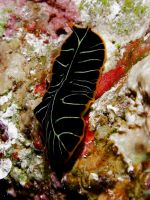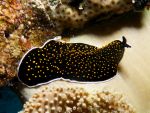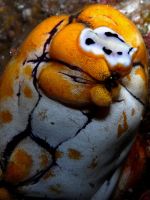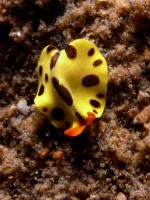Articles
Meeting with the flatworms
3-12-2010
Flatworms, like nudibranchs are very beautiful and interesting creatures. Many people are unable to differentiate them from the nubranchs although the difference is more than evident. Flatworms belong to the group Platyhelminthes, and as the name suggests, they are dorsoventrally flattened. Among platyhelminths you can find both free living and parasitic species. Their intestins have a dead end and is variously branched. An interesting feature is called subcutaneous sac made up of circular and longitudinal muscle, including dorsoventral and oblique muscles. For secretion they have protonefridia (amoeba cell with channels). The nervous system consists of ganglia in the head part of the body and nerve strands linked with cross passages. They are mostly hermaphrodites reproducing sexually by exchanging sperm between two individuals or asexually by dividing of the body). They have a significant ability to regenerate themselves. Earlier systematic division of platyhelmints was flatworms, tapeworms (cestoda), and fluke wormes (trematoda). According to the current view of phylogenetic relations, the class Turbellaria (flatworms) is now divided into three groups. The first two classes significantly differ by the primitive body structure from the remaining group Rhabditophora (flatworms). Rhabditophora includes the most species of the former group of Turbellaria. They are mostly free-living flatworsm living in marine, freshwater environment or in soil. Some species are parasitic. These are the typical flatworms that have a rod-shaped inclusions in cells (rhabdity). After excluding these units from their body these structures ballooned in the mucilaginous material used for defense, protection from drying out or to immobilize prey. Another type is produced by rhabditys gland cells in the mesenchyme. They move by swimming, crawling or by mucus secretion. The body is covered with epithelium containing normal glandular cells and cells with cilli. The crawling of large species of flatworms is allowed by progressive muscular contractions of the lower surface of the body or by waving the edges of the body. At the front of the body they have inverted eyes (usually in a characteristic distribution) and chemoreceptors. Mouth and anus is either at the front of the body or on the ventral side. Pharynx is usually simple pharynx plicatus or absorbent pharynx bullosus. Species living in flowing fresh water are used as bioindicators of water purity.
We meet occasionally large and beautifully colored species of flatworms in the sea. These belong to group called Polycladida. They have highly branched intestines and also nervous system.
It is really hypnotizing to watch swimming flatworms especially for a photographer. One of my favorite species in the Red Sea is a beautiful Thysanozoon nigropapillosum described in 1959. It has black coloration with white trim and on the back it has yellow papillas. Usually it has about 5 cm so it can not be easily overlooked. Very abundant flatworm is also Pseudoceros dimidiatus, which is also dressed in black but with orange trim and a kind of green striations. It is often found on sandy bottom. Again, this one grows to five centimeters in size. Rarely seen is Prostheceraeus giesbrechtii in pink or blue form.
Of course we can also encounter flatworms in the Mediterranean Sea. Thysanozoon brocchii is 5 cm bog brown speckled flatworm with papillas on the back, from small species we could name brightly colored Prostheceraeus giesbrechtii , it has about 14 mm and belongs among jewels of the Mediterranean. Regarding flatworms living in our fresh waters and those belonging to the group Tricladida, where the intestins Other species are not bigger than 1 cm. Soil flatworms on the other hand, may grow up to 35 cm ( for example Bipalium kewense).
Flatworms are small animals and someone one could therefore say that they are not important. Flatworms act as predators and are therefore unnecesary in the ecosystem. Furthermore, in the sea it is particularly wonderful to watch them and to take pictures. So look around you, while diving in the seas or in our fresh waters, maybe you will encounter one as well.
back





